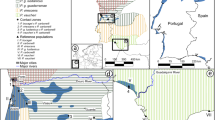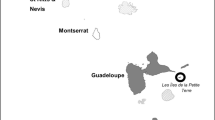Abstract
The island endemic Ctenosaura bakeri was listed as critically endangered by the IUCN Redlist Assessment in 2004, 7 years after it was recognized as a distinct species. C. bakeri occupies a portion of Utila, a small continental island located off the northern coast of Honduras. Habitat destruction and over-harvesting are among the top threats facing this species. In addition, morphological evidence of hybridization was recently documented, raising the concern that gene flow from the common and widely distributed C. similis could threaten the genetic distinctiveness of C. bakeri. We show that hybridization occurs only at low levels and is not a current threat to C. bakeri. All ctenosaurs captured for this study were identified to species level without difficulty; none had intermediate or mosaic phenotypes. Sequence analysis of mitochondrial and nuclear markers revealed only two individuals with introgressed genotypes. Molecular analysis of the previously described hybrid showed it to be heterozygous for C. bakeri and C. similis alleles. Hybridization between these two species is possible and occurs occasionally in the wild, and the rate of hybridization could increase if habitat destruction or changes in relative abundance increase the probability of interbreeding. However, the level of gene flow indicated by current data is too low to threaten C. bakeri with genetic swam** or deleterious fitness effects.



Similar content being viewed by others
References
Allendorf FW, Luikart G (2007) Conservation and the genetics of populations. Blackwell Publishing, London
Allendorf WF, Leary RF, Spruell P, Wenburg JK (2001) The problem with hybrids: setting conservation guidelines. Trends Ecol Evol 16:613–622. doi:10.1016/S0169-5347(01)02290-X
Anderson E (1948) Hybridization of the habitat. Evolution Int J Org Evolution 2:1–9. doi:10.2307/2405610
Anderson E, Stebbins GL (1954) Hybridization as an evolutionary stimulus. Evolution Int J Org Evolution 8:378–388. doi:10.2307/2405784
Arnold ML (2006) Evolution through genetic exchange. Oxford University Press, London
Bailey JW (1928) A revision of the lizards of the genus Ctenosaura. Proc US Nat Mus 73:1–69
Barton NH (1979) Gene flow past a cline. Heredity 43:333–339. doi:10.1038/hdy.1979.86
Blair AP (1941) Variation, isolating mechanisms, and hybridization in certain toads. Genetics 26:398–417
Campbell JA (1998) Amphibians and reptiles of northern Guatemala, the Yucután, and Belize. University of Oklahoma Press, Norman
de Queiroz K (1987) A new spiny-tailed iguana from Honduras, with comments on relationships within Ctenosaura (Squmata: Iguania). Copeia 1987:892–902. doi:10.2307/1445552
de Queiroz K (1990) Catalogue of American Amphibians and Reptiles: Ctenosaura bakeri. Society for the Study of Amphibians and Reptiles
Felsenstein J (1985) Confidence-limits on phylogenies—an approach using the bootstrap. Evolution Int J Org Evolution 39:783–791. doi:10.2307/2408678
Fitzpatrick BM, Shaffer HB (2007a) Hybrid vigor between native and introduced salamanders raises new challenges for conservation. Proc Natl Acad Sci USA 104:15793–15798. doi:10.1073/pnas.0704791104
Fitzpatrick BM, Shaffer HB (2007b) Introduction history and habitat variation explain the landscape genetics of hybrid tiger salamanders. Ecol Appl 17:598–608. doi:10.1890/06-0369
Gutsche A (2005) Distribution and habitat utilization of Ctenosaura bakeri on Utila. Iguana 12:143–151
Haig SM, Mullins TD, Forsman ED, Trail PW, Wennerberg L (2004) Genetic identification of spotted owls, barred owls, and their hybrids: legal implications of hybrid identity. Conserv Biol 18:1347–1357. doi:10.1111/j.1523-1739.2004.00206.x
Hollingsworth BD (2004) The evolution of iguana: an overview of relationships and a checklist of species. In: Alberts AC, Carter RL, Hayes WK, Martins (eds) Iguanas: biology, conservation. University of California Press, Berkeley, pp 19–34
Iwabe N, Hara Y, Kumazawa Y, Shibamoto K, Saito Y, Miyata T et al (2005) Sister group relationships of turtles to the bird-crocodilian clade revealed by nuclear DNA-coded proteins. Mol Biol Evol 22:810–813. doi:10.1093/molbev/msi075
Köhler G (2003) The reptiles of Central America. Herpeton, Verlag Elke Köhler, Offenbach, Germany
Köhler G, Blinn E (2000) Naturliche Bastardierung zwischen Ctenosaura bakeri und Ctenosaura similis auf Utila, Honduras. Salamandra (Frankf) 36:1–3
Köhler G, Schroth W, Streit B (2000) Systematics of the Ctenosaura group of lizards (Reptilia: Sauris: Iguanidae). Amphib-reptil 21:177–191. doi:10.1163/156853800507363
Köhler G, Vesely M, Greenbaum E (2006) The amphibians and reptiles of El Salvador. Krieger Publishing Company, Malabar, Florida
Lee JC (1996) The amphibians and reptiles of the Yucután Peninsula. Comstock Publ. Assoc., Cornell Univ. Press, Ithaca, New York
Lenormand T (2002) Gene flow and the limits to natural selection. Trends Ecol Evol 17:183–189. doi:10.1016/S0169-5347(02)02497-7
Lewontin RC, Birch LC (1966) Hybridization as a source of variation for adaptation to new environments. Evolution Int J Org Evolution 20:315–336. doi:10.2307/2406633
Maddison DR, Maddison WP (2005) MacClade 4 release version 4.07 for OSX. Sinauer Associates, Inc, Sunderland, Massachusetts
McCranie JR, Wilson LD, Köhler G (2005) Amphibians and reptiles of the Bay Islands and Cayos Cochinos, Honduras.. Bibliomania, Salt Lake City, Utah, USA
Norell MA, de Queiroz K (1991) The earliest Iguanine lizard (Reptilia: Squamata) and its bearing on Iguanine phylogeny. Am Mus Novit 2997:1–16
O’Brien SJ, Mayr E (1991) Bureaucratic mischief: recognizing species and subspecies. Science 251:1187–1188. doi:10.1126/science.251.4998.1187
Pasachnik SA (2006) Ctenosaurs of Honduras: notes from the field. Iguana 13:264–271
Posada D, Crandall KA (1998) Modeltest: testing the model of DNA substitution. Bioinformatics 14:817–818. doi:10.1093/bioinformatics/14.9.817
Rassmann K (1997) The evolutionary age of the Galapagos iguanas predates the age of the present Galapagos Islands. Mol Phylogenet Evol 7:158–172. doi:10.1006/mpev.1996.0386
Reisenbichler RR, Rubin SP (1999) Genetic changes from artificial propagation of Pacific salmon affect the productivity and viability of supplemented populations. ICES J Mar Sci 56:459–466. doi:10.1006/jmsc.1999.0455
Rhymer JM, Simberloff D (1996) Extinction by hybridization and introgression. Annu Rev Ecol Syst 27:83–109. doi:10.1146/annurev.ecolsys.27.1.83
Ronquist F, Huelsenback JP (2003) MRBAYES 3: bayesian phylogenetics inference under mixed models. Bioinformatics 19:1572–1574. doi:10.1093/bioinformatics/btg180
Rozas J, Sanchez-Delbarrio JC, Messeguer X, Rozas R (2003) DnaSP, DNA polymorphism analysis by the coalescent and other methods. Bioinformatics 19:2496–2497. doi:10.1093/bioinformatics/btg359
Savage JM (2002) The amphibians and reptiles of Costa Rico: a herpetofauna between two continents, between two seas. University of Chicago Press, Chicago, Illinois
Seehausen O, van Alphen JJM, Witte F (1997) Cichlid fish diversity threatened by eutrophication that curbs sexual selection. Science 277:1808–1811. doi:10.1126/science.277.5333.1808
Sites JW Jr, Davis SK, Guerra T, Iverson JB, Snell HW (1996) Character congruence and phylogenetic signal in molecular and morphological data sets: a case study in the living iguanas (Squamata, Iguanaidae). Mol Biol Evol 13:1087–1105
Stafford PJ, Meyer JR (2000) A guide to the reptiles of Belize. The Natural History Museum, London and Academic Press, New York
Stejneger L (1899) Description of a new species of spiny-tailed iguana from Guatemala. Proc US Nat Mus 21:381–383
Stejneger L (1901) On a new species of spiny-tailed iguana from Utila Island, Honduras. Proc US Nat Mus 23:467–468
Swofford DL (2002) PAUP*. Phylogenetic analysis using parsimony (*and other methods). Version 4.0. Sinauer Associates, Sutherland, Massachusetts
Weir BS (1996) Genetic data analysis II. Sinauer Associates, Inc. Publishers, Sunderland, Massachusetts
Wiens JJ, Hollingsworth BD (2000) War of the iguanas: conflicting molecular and morphological phylogenies and long branch attraction in iguanid lizards. Syst Biol 49:143–159. doi:10.1080/10635150050207447
Wright S (1931) Evolution in Mendelian populations. Genetics 16:97–159
Zoerner S, Köhler G (2004) Ctenosaura bakeri. In: IUCN 2006. 2006 IUCN Red List of Threatened Species. www.iucnredlist.org. Downloaded on 16 August 2007
Acknowledgments
This study would not have been possible without the help of many amazing field volunteers: Dennis Baulechner, Jeffery Corneil, Corey Shaffer, Jeff Liechty, Wendy Naira, Melissa Issis Medina, Sammy Nuñez, and Hadas Grushka, many thoughtful discussions with James Fordyce and Sally Horn, The Utila Iguana Research and Breeding Station, the Overseas Research Station on Roatan and David Evans, the Cayos Cochinos Foundation, the many offices of AFE-COHDEFOR, the multitude of local residents and guides, and grants to S.A.P. from Sigma ** and the International Iguana Foundation, and the Department of Ecology and Evolutionary Biology of the University of Tennessee, Knoxville. All procedures were approved by the University of Tennessee, Knoxville, Institutional Animal Care and Use Committee.
Author information
Authors and Affiliations
Corresponding author
Rights and permissions
About this article
Cite this article
Pasachnik, S.A., Fitzpatrick, B.M., Near, T.J. et al. Gene flow between an endangered endemic iguana, and its wide spread relative, on the island of Utila, Honduras: when is hybridization a threat?. Conserv Genet 10, 1247–1254 (2009). https://doi.org/10.1007/s10592-008-9692-0
Received:
Accepted:
Published:
Issue Date:
DOI: https://doi.org/10.1007/s10592-008-9692-0




